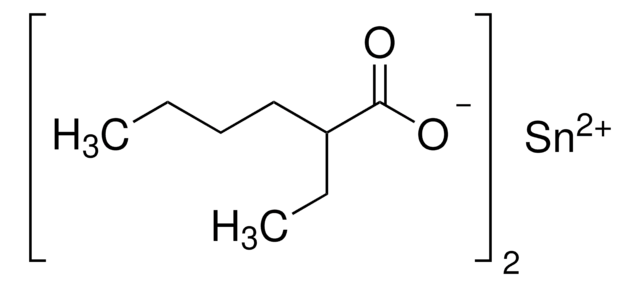All Photos(2)
About This Item
Linear Formula:
(HO)2C6H3CO2CH2CH3
CAS Number:
Molecular Weight:
182.17
MDL number:
UNSPSC Code:
12352100
PubChem Substance ID:
NACRES:
NA.22
Recommended Products
Assay
97%
mp
127-130 °C (lit.)
functional group
ester
SMILES string
CCOC(=O)c1cc(O)cc(O)c1
InChI
1S/C9H10O4/c1-2-13-9(12)6-3-7(10)5-8(11)4-6/h3-5,10-11H,2H2,1H3
InChI key
APHYVLPIZUVDTK-UHFFFAOYSA-N
General description
Ethyl 3,5-dihydroxybenzoate is a dihydroxybenzoic ester. It can be synthesized from 3,5-dihydroxybenzoic acid by esterification process with absolute ethanol.
Application
Ethyl 3,5-dihydroxybenzoate may be used as a starting reagent in the synthesis of ethyl 3,5-bis(ω-hydroxyoligo(ethyleneoxy))benzoates and p-alkoxycarbonylated palladium bis(phosphinite) PCP pincer complexes.
Signal Word
Warning
Hazard Statements
Precautionary Statements
Hazard Classifications
Acute Tox. 4 Oral - Eye Irrit. 2 - Skin Irrit. 2 - STOT SE 3
Target Organs
Respiratory system
Storage Class Code
11 - Combustible Solids
WGK
WGK 3
Flash Point(F)
Not applicable
Flash Point(C)
Not applicable
Personal Protective Equipment
dust mask type N95 (US), Eyeshields, Gloves
Regulatory Information
新产品
Choose from one of the most recent versions:
Certificates of Analysis (COA)
Lot/Batch Number
Don't see the Right Version?
If you require a particular version, you can look up a specific certificate by the Lot or Batch number.
Already Own This Product?
Find documentation for the products that you have recently purchased in the Document Library.
Structural variants of hyperbranched polyesters.
Kumar A and Ramakrishnan S.
Macromolecules, 29(7), 2524-2530 (1996)
PCP-Bis (phosphinite) pincer complexes: new homogeneous catalysts for a-arylation of ketones.
Churruca F, et al.
Tetrahedron Letters, 47(19), 3233-3237 (2006)
José Antonio Curiel et al.
Journal of agricultural and food chemistry, 57(14), 6224-6230 (2009-07-16)
Tannase is an enzyme with important biotechnological applications in the food industry. Previous studies have identified the tannase encoding gene in Lactobacillus plantarum and also have reported the description of the purification of recombinant L. plantarum tannase through a protocol
Our team of scientists has experience in all areas of research including Life Science, Material Science, Chemical Synthesis, Chromatography, Analytical and many others.
Contact Technical Service









